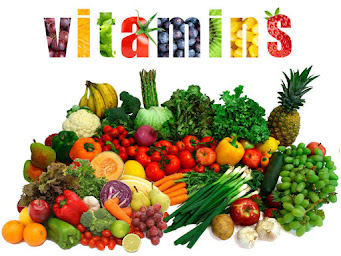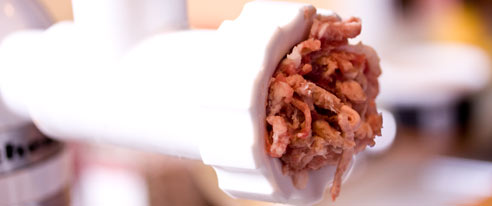VITAMINS
VITAMINS
• Coined from the term ‘vital amine’, as early scientists felt the chemical amines vital for life.
• Like carbohydrates, proteins and fats they are organic compounds.
• Micronutrient
• Vitamin term is used for a group of potent organic compounds other than proteins, carbohydrates and fats occurring in minute amounts and are essential for some specific body functions such as regulation, maintenance, growth and protection. Many cannot be synthesized by the body and must be obtained from the diet.
CLASSIFICATION
• Grouped according to their solubility in either fat or water:
q Fat-soluble vitamins: Vitamins A, D, E and K. They require fat for their absorption and can be stored in the body. If their intake is poor, but the body stores are ample, deficiency symptoms will not be seen immediately.
q Water-soluble vitamins: B-Complex vitamins and Vitamin C. Being water soluble they are easily absorbed and the excess consumed is excreted from the urine. They are not stored in body.
VITAMIN A
Introduction:
q Generic name given to a group of compounds (retinal, retinol, and retinoic acid) having vitamin A activity.
q Found only in fatty phases of foods of animal origin.
q Carotene pigments are converted into Vitamin A in the body. i.e., carotene is a provitamin or precursor of vitamin A. Carotene is synthesized by plants and is ultimate source of all vitamin A.
Functions:
q Maintains normal vision in dim light. Rhodopsin is formed when vit. A combines with protein opsin and is required for vision in dim light. If deficiency of vit. A, the regeneration is slow and the person’s eyes fail to adapt changes in light.
q Helps in synthesis and maintenance of healthy epithelium – outermost lining of skin and innermost lining of mucous membranes of respiratory and gastrointestinal tract.
q Required for normal bone and tooth development, and proper growth.
q Helps body to fight against infections by keeping mucous membranes in a healthy condition preventing infection.
Deficiency:
q Night blindness: Earliest sign of its deficiency. A person is unable to see well in dim light, especially coming from bright light. Happens because there is insufficient vit A to bring quick formation of rhodopsin.
q Epithelial changes: The epithelium becomes dry, scaly, and rough. Goose pimples are seen on upper forearms and thighs.
q Growth failure and stunted bones are seen in children.
q Changes in eyes are:
-Secretion of tears decreases
-Eyeball becomes dry and lustreless
-Photophobia or sensitivity to bright light is observed
-Xeropthalmia – cornea becomes dry and inflammed.
-Keratomalacia or softening of cornea and permanent blindness results.
• Hypervitaminosis A
q High doses of it is not recommended as excess is stored in liver. This excessive accumulation of vit A in the body is toxic. Symptoms of toxicity are nausea, vomiting, abdominal pain, loss of hair, thickening of long bones and joint pain.
• Sources
q Animal foods such as milk and milk products, egg yolk, oily fish, fish-liver oils, organ meats, butter, cream and clarified butter.
• Requirement
q An adult require 600µg of retinol or 2400µg of β-carotene per day.
VITAMIN D
• Two important forms are Vitamin D2 (activated ergosterol or calciferol) and Vitamin D3 (activated 7-dehydrocholesterol or cholecalciferol).
• Vit D3 is produced when 7-dehyrocholesterol in the skin is exposed to UV rays in the sun.
• Functions:
q Absorption of calcium and phosphorus from the small intestine requires the presence of vit D and the hormones of the parathyroid and thyroid gland.
q Mineralization of bones and teeth – after calcium and phosphorus is absorbed, vit D is required to ensure that these minerals are deposited in bones and teeth to strengthen them.
q Regulation of calcium and phosphorus levels in blood.
• Sources:
q Sunlight is the main source.
q Precursor in skin is converted to active vitamin D3 .
q Barriers – Clothing, fog, window glass, sunscreen lotions, etc.
q Found in fish liver oils, fortified milk, vanaspati ghee, butter, milk, etc.
• Deficiency:
• Leads to lowered absorption of calcium, low serum levels of calcium, and reduced bone mineralization.
• Rickets in infants and children especially dark-skinned children. Bones soften and yield to pressure.
• Osteomalacia or adult rickets is seen in women who consume a diet deficient in calcium, phosphorus, and vitamin D. It leads to deformed spine, rheumatic pain in legs and lower back and spontaneous fracture.
VITAMIN E
• Vit. E or tocopherol is stable to heat and acids and rapidly oxidized in rancid fats.
• Functions:
q Most potent antioxidant found in food.
q It gets oxidized and protects cell membranes from oxidative damage.
q It prevents oxidation of vitamin A in intestine.
q Protects normal cell membranes by preventing their breakdown.
q Prevents oxidation of PUFAs.
• Sources:
q Vegetable oils (corn, soya, sunflower, safflower, etc.), wheat germ, whole grains, legumes, nuts and dark green leafy vegetables.
Vitamin K
• Vitamin K is essential in diet as it is needed for synthesis of prothrombin and other blood clotting factors.
• Functions:
q The ability of blood to clot is dependent upon a high blood level of prothrombin.
• Deficiency:
q Uncommon in adults
q Reduces clotting tendency of blood.
• Sources:
q Bacterial synthesis in the intestinal tract supplies at least half of the daily needs. Green leafy vegetables, cabbage, cauliflower and pork liver, cheese, egg yolk, and tomato.
B-COMPLEX VITAMINS
• Eight B-complex vitamins are essential for humans and they are:
q Thiamine (vitamin B1)
q Riboflavin (vitamin B2)
q Niacin (vitamin B3)
q Pyridoxine (vitamin B6)
q Pantothenic acid (vitamin B5)
q Biotin (vitamin B7)
q Folic acid (vitamin B9)
q Cyanocobalamin (vitamin B12)
• Thiamine
(vitamin B1)
It performs the following functions:
q It functions mainly as a co-enzyme, thiamine pyrophosphate (TPP), which is required in the breakdown of glucose to yield energy.
q It helps to maintain a healthy nervous system.
q It is needed for normal appetite and disgestion.
Daily requirement of thiamine is 0.5 mg/1000 kcal.
Sources: Foods rich in protein such as pork, liver, pulses, groundnut, and eggs are good sources. Soyabean, whole grain and enriched cereals, sprouted pulses are rich source.
Deficiency: Early symptoms include fatigue, irritability, depression, poor appetite, numbness of legs. Severe deficiency causes beri-beri.
q Dry beri- beri: Inflammation of nerves, numbness, muscle weakness, and cramps are main symptoms.
q Wet beri-beri: Severe oedema, enlargement of heart, palpitation, and increase in rate of heart beat are seen.
• Riboflavin
(vitamin B2)
It performs following functions:
q As a co-enzyme, just like B1 is a vital factor in carbohydrate metabolism; B2 is vital in protein metabolism.
q B2 is a constituent of co-enzymes flavin mono nucleotide (FMN) and flavin adenine dinucleotide (FAD).
Daily requirement is 0.55 mg/ 1000 kcal.
Sources: Milk and cheese along with organ meats, eggs, dark green vegetables and enriched cereal foods.
Deficiency:
q Swelling of lips with cheilosis
q Cracks in the skin at the corners of the lip, i.e. Angular stomatitis
q Redness and swelling of the tongue
Eyes look bloodshot, eye fatigue, itching, burning, watering, and sensitivity to bright light, i.e. Photophobia.
• Niacin
(vitamin B3)
Niacin or nicotinic acid is a vitamin intimately connected with several metabolic reactions it takes part in as a component.
Functions: Like B1 and B2, niacin is also required for enzymes that bring about breakdown of glucose, amino acids, and fatty acids to yield energy, i.e. for release of energy from food.
q As a constituent of two co-enzymes, nicotinamide adenine dinucleotide (NAD) and nicotinamide adenine dinucleotide phosphate (NADP), to release energy from carbohydrates, proteins and fats.
q For a healthy skin, normal gastro-intestinal tract, and maintenance of the nervous system.
Sources: Poultry, fish, meat, groundnut, beans, and peas.
Deficiency: Pellagra, which means rough skin, is characterized by 4 D’s – diarrhoea, dermatitis, dementia and death. In severe deficiency, it leads to depression, confusion, poor memory and hallucinations.
·
Folic acid (vitamin B9)
Derives its name from term ‘folium’ meaning leaf.
Sources: Liver, kidney, green leafy vegetables, whole pulses and yeast and in fermented foods as well.
Deficiency: Results in megaloblastic anaemia. Megaloblasts are large nucleated cells or immature RBCs. Haemoglobin levels fall.
Cyanocobalamin (vitamin B12)
Functions:
q It helps folic acid in the synthesis and maturation of RBCs.
q It is essential for formation of myelin sheath around nervous system.
Sources: Found in animal origin. Liver, kidney, milk, eggs, and cheese.
Deficiency: It results in megaloblastic anaemia or in pernicious anaemia. Latter is more common and serious.
Vitamin - C
• Also known as Ascorbic acid, was discovered as an acid in lime juice which prevented scurvy among British sailors on long voyages at sea.
• Highly soluble in water and most easily destroyed as compared to all other vitamins. Lost when food is dehydrated.
Functions:
q Synthesis of collagen which is the intercellular cementing substance that keeps cells in bone and muscle tissue together.
q Making haemoglobin by helping in absorption of iron from food.
q Healing of wounds and fractures.
q Increasing resistance to infections and fevers.
q Proper growth during periods of increased need or during rapid growth
q As an antioxidant, like vit A, it prevents the oxidation of vit A and unsaturated fatty acids.
Sources:
Fresh citrus fruits; other fruits and vegetables such as guava, amla, cabbgae, capsicum, green chillies, green leafy vegetables and tomatoes.






nice work dearlokking forword for more
ReplyDeletehttps://www.ehospitalitystudy.in/courses/
https://www.ehospitalitystudy.in